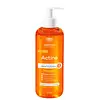What's inside
What's inside
 Key Ingredients
Key Ingredients

 Benefits
Benefits

 Concerns
Concerns

 Ingredients Side-by-side
Ingredients Side-by-side

Water
Skin ConditioningDecyl Glucoside
CleansingPolysorbate 20
EmulsifyingCeteareth-60 Myristyl Glycol
EmulsifyingGlycerin
HumectantDisodium Cocoamphodiacetate
CleansingSodium Lauroyl Sarcosinate
CleansingMethyl Gluceth-20
HumectantAlcohol
AntimicrobialAloe Barbadensis Leaf Extract
EmollientBenzoic Acid
MaskingCetrimonium Bromide
AntimicrobialCucurbita Pepo Seed Oil
EmollientDisodium EDTA
EDTA
Parfum
MaskingLactic Acid
BufferingMenthyl Lactate
MaskingMethylparaben
PreservativePhenoxyethanol
PreservativePropylene Glycol
HumectantPropylparaben
PreservativeZinc Gluconate
Skin ConditioningWater, Decyl Glucoside, Polysorbate 20, Ceteareth-60 Myristyl Glycol, Glycerin, Disodium Cocoamphodiacetate, Sodium Lauroyl Sarcosinate, Methyl Gluceth-20, Alcohol, Aloe Barbadensis Leaf Extract, Benzoic Acid, Cetrimonium Bromide, Cucurbita Pepo Seed Oil, Disodium EDTA, EDTA, Parfum, Lactic Acid, Menthyl Lactate, Methylparaben, Phenoxyethanol, Propylene Glycol, Propylparaben, Zinc Gluconate
Sodium Palmate
CleansingWater
Skin ConditioningSodium Stearate
CleansingSodium Palm Kernelate
CleansingGlycerin
HumectantSodium C14-16 Olefin Sulfonate
CleansingDisodium Laureth Sulfosuccinate
CleansingButylphenyl Methylpropional
PerfumingSodium Chloride
MaskingMethyl Gluceth-20
HumectantTitanium Dioxide
Cosmetic ColorantSodium Acetate
BufferingBHT
AntioxidantSodium Hydroxide
BufferingCalendula Officinalis Extract
Skin ConditioningAlcohol Denat.
AntimicrobialDimethylhydroquinone
PerfumingEtidronic Acid
Disodium Distyrylbiphenyl Disulfonate
UV AbsorberAcid Blue 74
Ethylhexylglycerin
Skin ConditioningPhenoxyethanol
PreservativePotassium Sorbate
PreservativeSodium Benzoate
MaskingAloe Barbadensis Leaf Extract
EmollientSodium Palmate, Water, Sodium Stearate, Sodium Palm Kernelate, Glycerin, Sodium C14-16 Olefin Sulfonate, Disodium Laureth Sulfosuccinate, Butylphenyl Methylpropional, Sodium Chloride, Methyl Gluceth-20, Titanium Dioxide, Sodium Acetate, BHT, Sodium Hydroxide, Calendula Officinalis Extract, Alcohol Denat., Dimethylhydroquinone, Etidronic Acid, Disodium Distyrylbiphenyl Disulfonate, Acid Blue 74, Ethylhexylglycerin, Phenoxyethanol, Potassium Sorbate, Sodium Benzoate, Aloe Barbadensis Leaf Extract
 Reviews
Reviews

Ingredients Explained
These ingredients are found in both products.
Ingredients higher up in an ingredient list are typically present in a larger amount.
Aloe Barbadensis Leaf Extract is an extract of the leaves of the aloe, Aloe barbadensis, Liliaceae.
Aloe is one of the most well-known natural soothing ingredients, and for good reason. It’s full of water and has a cooling, calming effect on the skin, especially when it’s sunburned, itchy, or irritated. Aloe also helps your skin stay hydrated and smooth by mimicking what healthy skin naturally produces. On top of that, it contains vitamins and nutrients that support skin recovery.
It doesn’t protect you from the sun, but it can help your skin bounce back after too much time in it.
Let’s get into the details:
Aloe contains antioxidant Vitamins A, C, and E, which help fight off free radicals (unstable molecules from things like pollution that can damage your skin).
It’s also rich in polysaccharides, which are natural sugars that help hydrate the skin by acting like the skin’s own moisturizing agents. These, along with other sugars like monosaccharides, help form a protective barrier that locks in moisture.
Aloe works as both a humectant and an emollient. That means it draws water into the skin (humectant) and helps trap it there (emollient), making it an effective natural moisturizer.
You’ll also find a mix of other skin-supporting ingredients in aloe, including folic acid, choline, calcium, amino acids, fatty acids, and even Vitamin B12.
Out of the 420+ species of aloe, Aloe barbadensis is the most widely used in skincare products thanks to its gentle yet effective properties.
There are over 420 species of aloe but Aloe Barbadensis is the most commonly used for topical products.
Learn more about Aloe Barbadensis Leaf ExtractGlycerin is already naturally found in your skin. It helps moisturize and protect your skin.
A study from 2016 found glycerin to be more effective as a humectant than AHAs and hyaluronic acid.
As a humectant, it helps the skin stay hydrated by pulling moisture to your skin. The low molecular weight of glycerin allows it to pull moisture into the deeper layers of your skin.
Hydrated skin improves your skin barrier; Your skin barrier helps protect against irritants and bacteria.
Glycerin has also been found to have antimicrobial and antiviral properties. Due to these properties, glycerin is often used in wound and burn treatments.
In cosmetics, glycerin is usually derived from plants such as soybean or palm. However, it can also be sourced from animals, such as tallow or animal fat.
This ingredient is organic, colorless, odorless, and non-toxic.
Glycerin is the name for this ingredient in American English. British English uses Glycerol/Glycerine.
Learn more about GlycerinMethyl Gluceth-20 is a humectant. Humectants help draw moisture from the air to your skin.
It is created by combining polyethylene glycol with glucose.
Phenoxyethanol is a preservative that has germicide, antimicrobial, and aromatic properties. Studies show that phenoxyethanol can prevent microbial growth. By itself, it has a scent that is similar to that of a rose.
It's often used in formulations along with Caprylyl Glycol to preserve the shelf life of products.
Water. It's the most common cosmetic ingredient of all. You'll usually see it at the top of ingredient lists, meaning that it makes up the largest part of the product.
So why is it so popular? Water most often acts as a solvent - this means that it helps dissolve other ingredients into the formulation.
You'll also recognize water as that liquid we all need to stay alive. If you see this, drink a glass of water. Stay hydrated!
Learn more about Water